Tessa’s Recipe Rundown
Taste: Buttery with the perfect balance of sweetness and saltiness.
Texture: Soft, fluffy, and tender with a golden brown exterior.
Ease: If you’re not familiar with making homemade bread, this roll recipe is a great place to start!
Pros: Easy, relatively quick, delicious, perfect for Thanksgiving or a special dinner.
Cons: None.
Would I make this again? Absolutely!
This post may contain affiliate links. Read our disclosure policy.
This Ultimate Dinner Roll recipe is the most delicious dinner roll recipe you and your family will ever try!
There’s no need to be intimidated by homemade yeast bread baking – especially with a practically foolproof recipe like this one for the best-ever Ultimate Dinner Rolls.
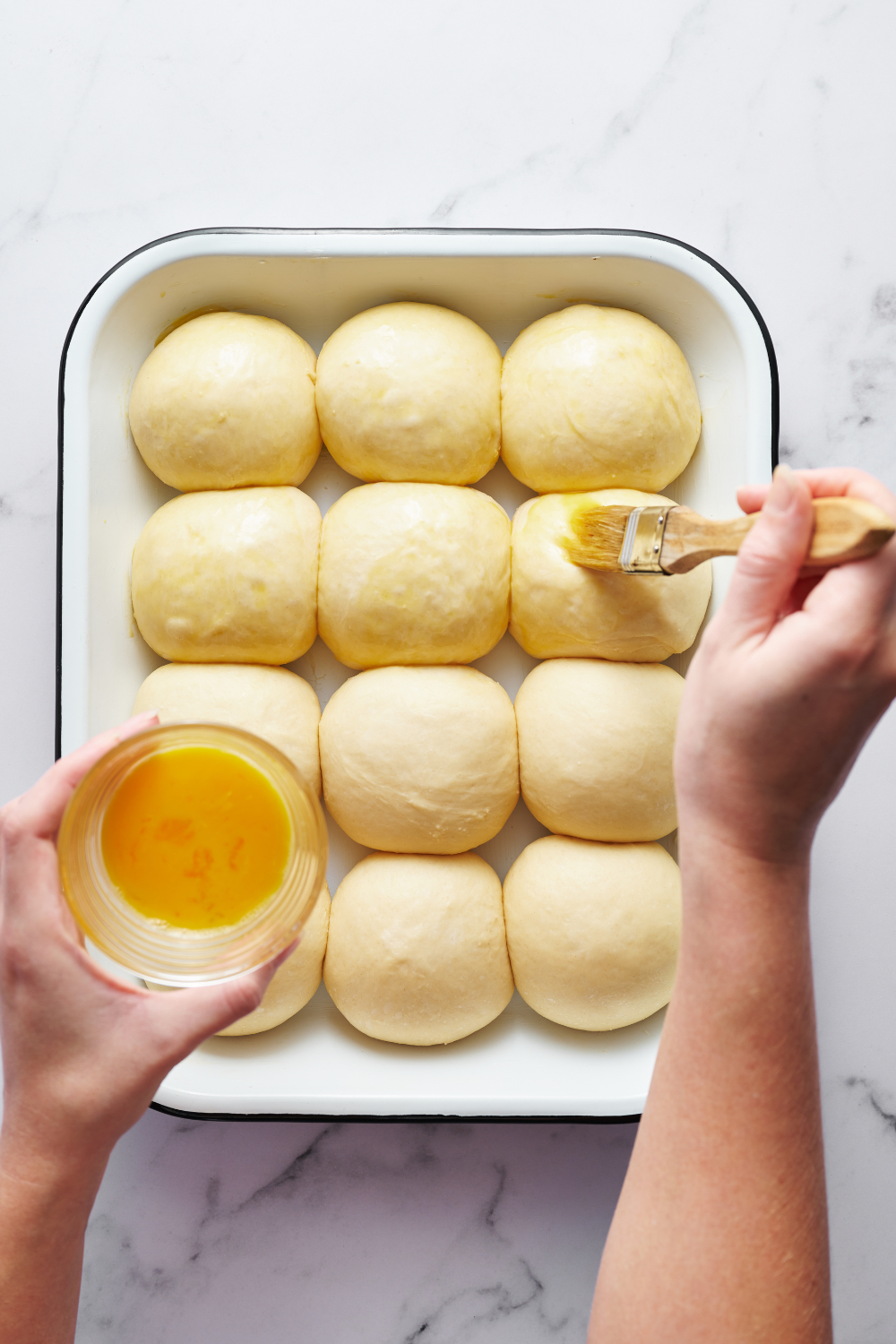
I promise this dinner roll recipe is way easier than it may seem. These will become the surprise star of your Thanksgiving dinner table, Easter brunch, or just your Sunday night family dinners!
I actually originally developed this recipe in 2013 after testing tons of tweaks on dinner rolls for my Ultimate Dinner Roll Guide post here. I learned exactly what made homemade dinner rolls fluffy or hard, tender or crusty, and compiled my favorite tweaks to create this recipe for Ultimate Dinner Rolls!
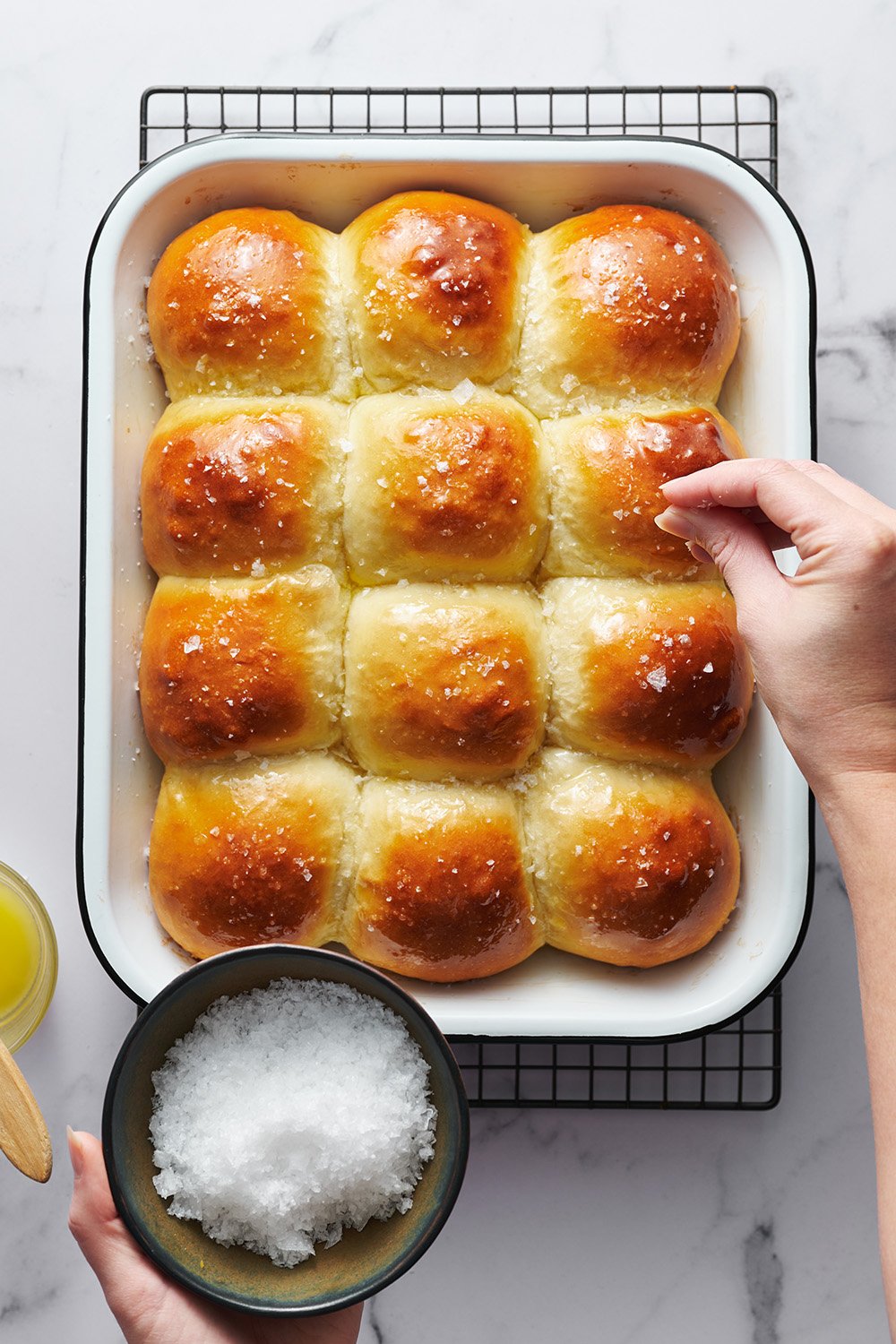
Over the years, I’ve continued to tweak and improve the recipe to make it even more soft, fluffy, and flavorful.
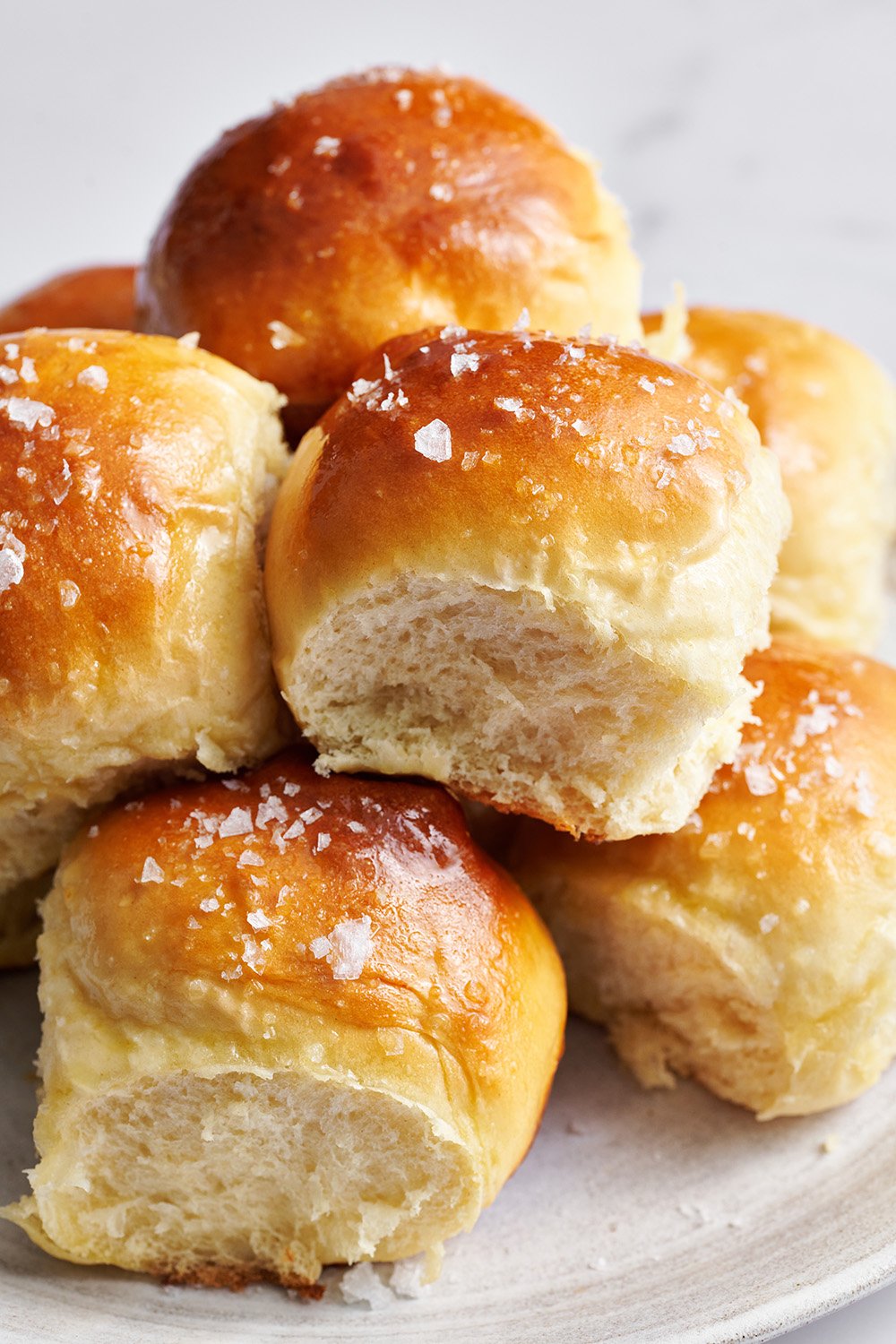

Sprinkle of Science
How to Make the Ultimate Dinner Rolls
Top Tips for Fluffy, Soft Dinner Rolls
- Avoid adding too much extra flour to the dough. This dough is enriched with milk, butter, and sugar. These ingredients slow down gluten development and can make the dough a little sticky. Your instinct might be to add extra flour; however, any extra flour will create a denser, tougher roll instead of the light, fluffy, soft dinner roll we want.
- Measure your flour correctly. I highly recommend using a digital kitchen scale for accuracy, but if you don’t have one, be sure to use the spoon and level method to ensure you’re not accidentally compacting too much flour in your measuring cups. Learn more about how to measure correctly here.
- Don’t skip the sugar. There’s just a touch in these dinner rolls, to help make the rolls tender and golden brown. Learn more about sugar’s role in baking here (spoiler alert: it does SO much more than simply sweetening!)
Do I Have to Use Bread Flour?
Bread flour has a higher level of protein content than all-purpose flour, which helps create tall dinner rolls with a nice chewy, fluffy texture. If you don’t have bread flour, use the same amount of all-purpose flour – but your rolls may just be slightly shorter and less chewy, and may take longer to knead and rise.
Which Yeast Is Best to Use For Dinner Rolls?
- This dinner roll recipe utilizes a shortcut ingredient: instant yeast, also called rapid-rise or quick-rise yeast.
- One of the three should be available at most grocery stores or you can buy my all-time favorite yeast on Amazon.
- These types of yeast are specifically formulated to allow you to skip proofing (aka the step where you combine the yeast with warm liquid for 5 minutes). You can add instant yeast directly into the mix with all of the ingredients.
- If you don’t have or can’t find instant yeast, you can easily use active dry yeast instead. Add it right in with the dry ingredients like instant yeast – just know the dough will take about 20% more time to rise.
- Or, to speed up that rise time slightly, simply combine it with the warm water and milk called for in the recipe and allow it to proof for 5 minutes before adding into the bowl with the other ingredients.
What Type of Milk Should I Use?
Whole milk produces the absolute best flavor and texture. I don’t recommend using a non-dairy or low-fat milk unless you absolutely must.
What Type of Salt for Dinner Rolls?
I recommend using fine sea salt inside the dinner rolls, and I also love sprinkling flaky sea salt on top of the freshly baked and buttered rolls, for even more flavor. Learn more about different types of salt here.
Can I Knead the Dough By Hand?
Yes! I call for a stand mixer to make easy work of kneading in this dinner roll recipe, but you can also knead by hand. Be sure to knead the dough properly, until the dough is smooth and elastic, to get rolls that hold their shape and bake up nice and fluffy. You can see my full tutorial on how to knead dough here.
How to Tell When Dough Is Risen
After kneading, shape the dough into a ball. Place in a lightly oiled mixing bowl. I like to use glass so I can see how much it’s rising. I’ll even snap an iPhone picture of the dough before rising so I can compare later. The dough should be turned over to oil the top so that it doesn’t dry out. Cover the bowl with plastic wrap, foil, or a clean kitchen towel. Let the dough rise in a warm, draft-free location. Ideal rise temperatures are between 80°F and 90°F. Lower temperatures will require more rising time; warmer temperatures will mean a shorter rising time.
The dough is done rising when it’s about doubled in size and passes the “ripe” test: gently stick two fingers in the risen dough up to the second knuckle and then take them out. If the finger marks remain, the dough is ready for shaping into balls. If not, cover and let the dough rise longer until it is.
The same finger test can be done again when the rolls are shaped before baking. Here’s what my dough looked like before and after rising:
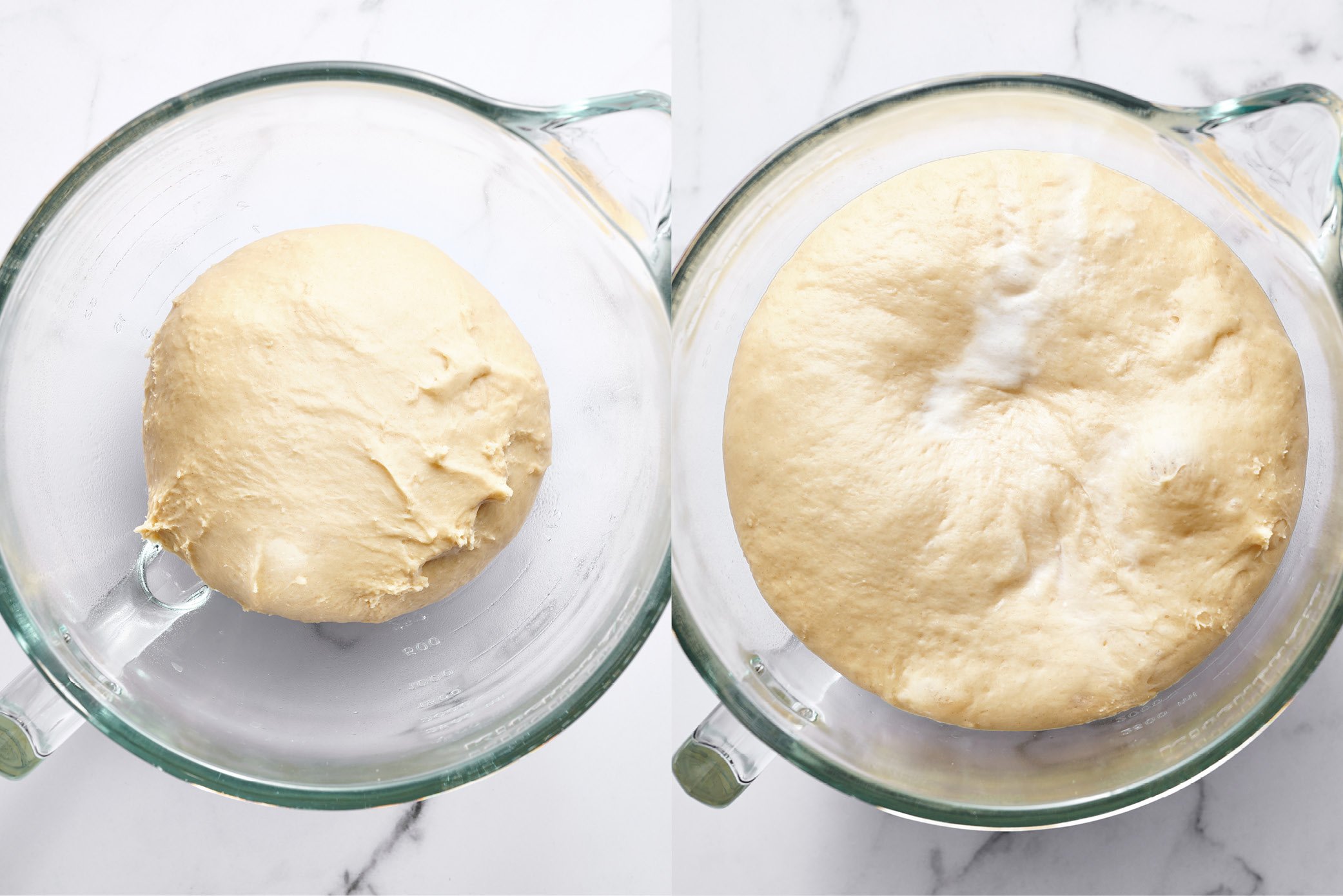
How to Shape Bread Rolls
- Once the dough is risen, press it down to gently deflate.
- Place the dough onto a clean surface (not a floured surface).
- Use a bench scraper to section the dough into 12 equal pieces. Don’t worry if they’re not perfectly equal in size. However, if you’re a perfectionist, you can weigh the entire mass of dough, divide that number by 12, and then portion each piece perfectly by weight.
- As you’re shaping each piece into a round, make sure to pinch the dough into one central point to create a tight ball. This will help the rolls rise beautifully. Don’t flour your work surface when shaping the rolls because you want some resistance to roll them into taut balls.
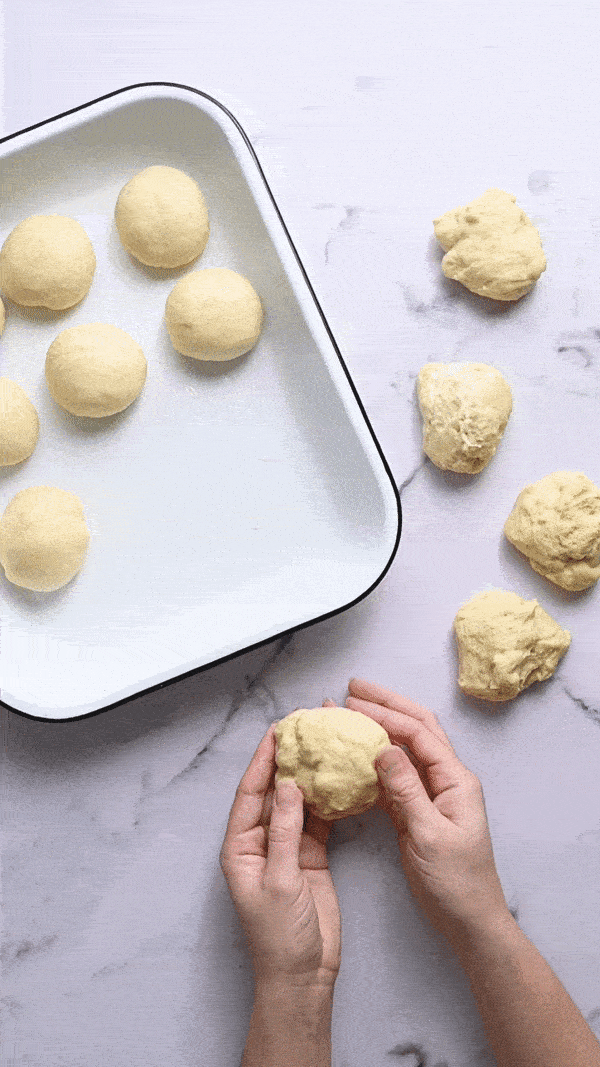
You can also get creative with shaping this dinner roll recipe! Check out my article for 5 Ways to Shape Bread Rolls here.
What Type of Pan for Dinner Rolls?
This recipe was written to use a 9×13-inch baking pan. While I usually prefer metal baking pans over glass or ceramic (metal conducts heat more efficiently), I actually prefer the table presentation ceramic pans offer when making dinner rolls. Also, because ceramic (and glass) conduct heat more slowly than metal, it allows these rolls to stay soft in the centers.
How to Make Dinner Rolls Ahead of Time
Most yeasted doughs can be made ahead of time and baked off later by simply chilling the dough. Refrigerating basically stunts the rise time and can actually allow more flavor to develop!
For this dinner roll recipe, here’s my recommended method:
- Make the dough all the way through to rising once and shaping into rolls.
- Once the rolls are shaped, cover the pan well with plastic wrap and place in the refrigerator for up to 24 hours.
- When ready to bake, bring to room temperature as the oven preheats before baking as the recipe directs.
- If the rolls haven’t doubled in size yet, allow to sit at room temperature until they do.
- The rolls are best served the day they’re baked. However, you can easily reheat the rolls briefly in the oven or toaster oven at 300°F until warmed through to refresh before serving.
If you need to prep these rolls further in advance, see the freezing instructions just below.
How to Freeze Dinner Rolls
- Freeze the dough after it has risen for the first time and been shaped.
- Place the rolls in a baking dish, cover tightly with plastic wrap, and store in the freezer for up to 2 months.
- When ready to bake, loosen the plastic wrap and thaw to room temperature.
- Let rise until an indentation made with your finger into the dough remains.
- Proceed with the recipe as written.
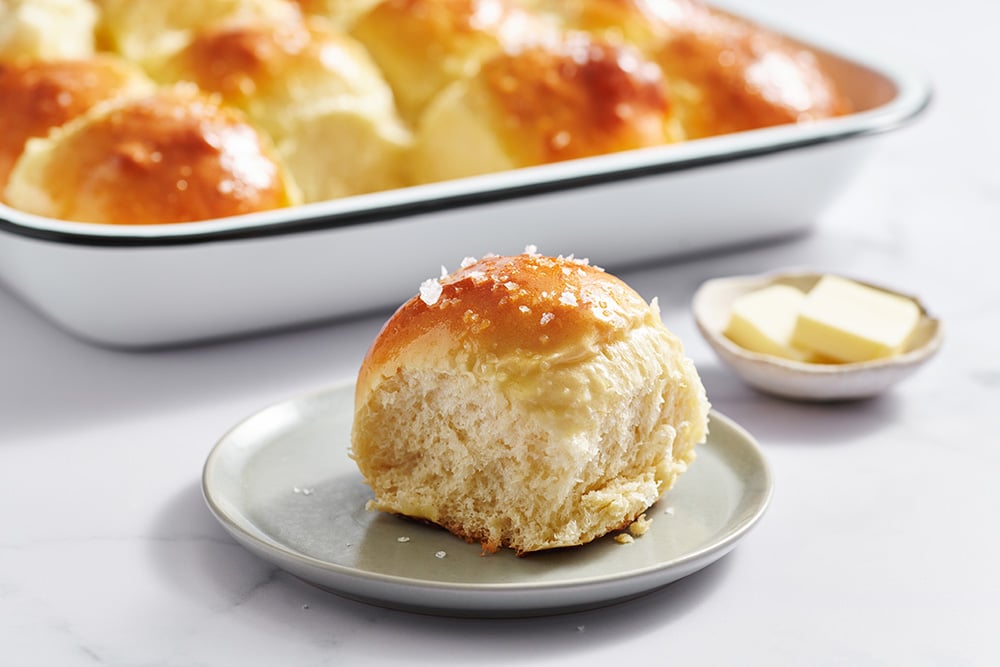
More Dinner Roll Recipes You’ll Love:
- Homemade Hawaiian Rolls
- Sweet Potato Dinner Rolls
- Ricotta Herb Bread Rolls
- Homemade Hawaiian Bread Rolls
- Garlic, Herb, and Cheese Bread Rolls

Become a Baking Genius!
Sign up for our free email newsletter for NEW recipes & baking science secrets.
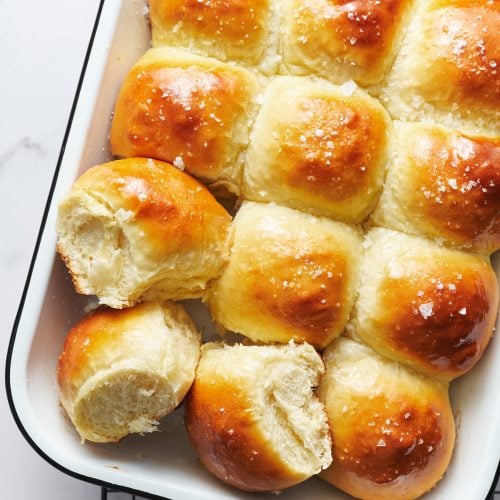
Ultimate Dinner Rolls
Ingredients
- 1/4 cup lukewarm water
- 1 cup warm milk (100 to 110°F)
- 1 tablespoon unsalted butter, melted plus more for greasing
- 2 large eggs, lightly beaten
- 2 tablespoons granulated sugar
- 1 1/2 teaspoons fine salt
- 2 1/4 teaspoons (1 packet) instant yeast
- 4 1/2 cups (572 grams) bread flour
For egg wash & finishing
- 1 egg, lightly beaten
- Melted butter
- Flaky sea salt, for sprinkling
Instructions
- Combine the water, milk, 1 tablespoon of the melted butter, eggs, sugar, salt, and yeast in the bowl of a stand mixer. Add 2 cups of the flour and stir with a wooden spoon until the dough forms a rough, shaggy mass. Attach the dough hook to the mixer, turn to medium-low speed, and gradually add the remaining flour, kneading until a mass of dough begins to form. Continue kneading on medium-high speed for 4 to 5 minutes until a soft, smooth ball of dough is formed. The dough should feel elastic and slightly tacky to the touch.
- Lightly spray a large clean bowl with cooking spray and place the dough in the bowl. Cover the bowl lightly with plastic wrap. Let rise for about 1 hour to 90 minutes at room temperature or until the dough is big, puffy, and about doubled in size.
- Grease a 9×13-inch or similarly shaped baking pan with butter. Gently deflate the dough. Use a bench scraper, knife, or pizza wheel to divide the dough into 12 equal pieces. Shape each piece into a ball and place in the prepared pan. Lightly cover the dough with plastic wrap and let the rolls rise for about 1 hour, or until about doubled in size.
- Preheat the oven to 375°F.
- Brush the rolls gently with the beaten egg. Bake the rolls for 20 minutes, or until golden brown. Brush with melted butter and sprinkle with salt. Serve warm. Store leftovers in an airtight container or ziptop bag for up to 3 days.
This recipe was originally published in 2013 and has been updated with new photos and more baking tips. Photos by Joanie Simon.

Previous Baking Challenge
This recipe was one of our recent picks for the Handle the Heat Baking Challenge. Every month, we select a recipe, you make it, snap a photo, and enter to win PRIZES!


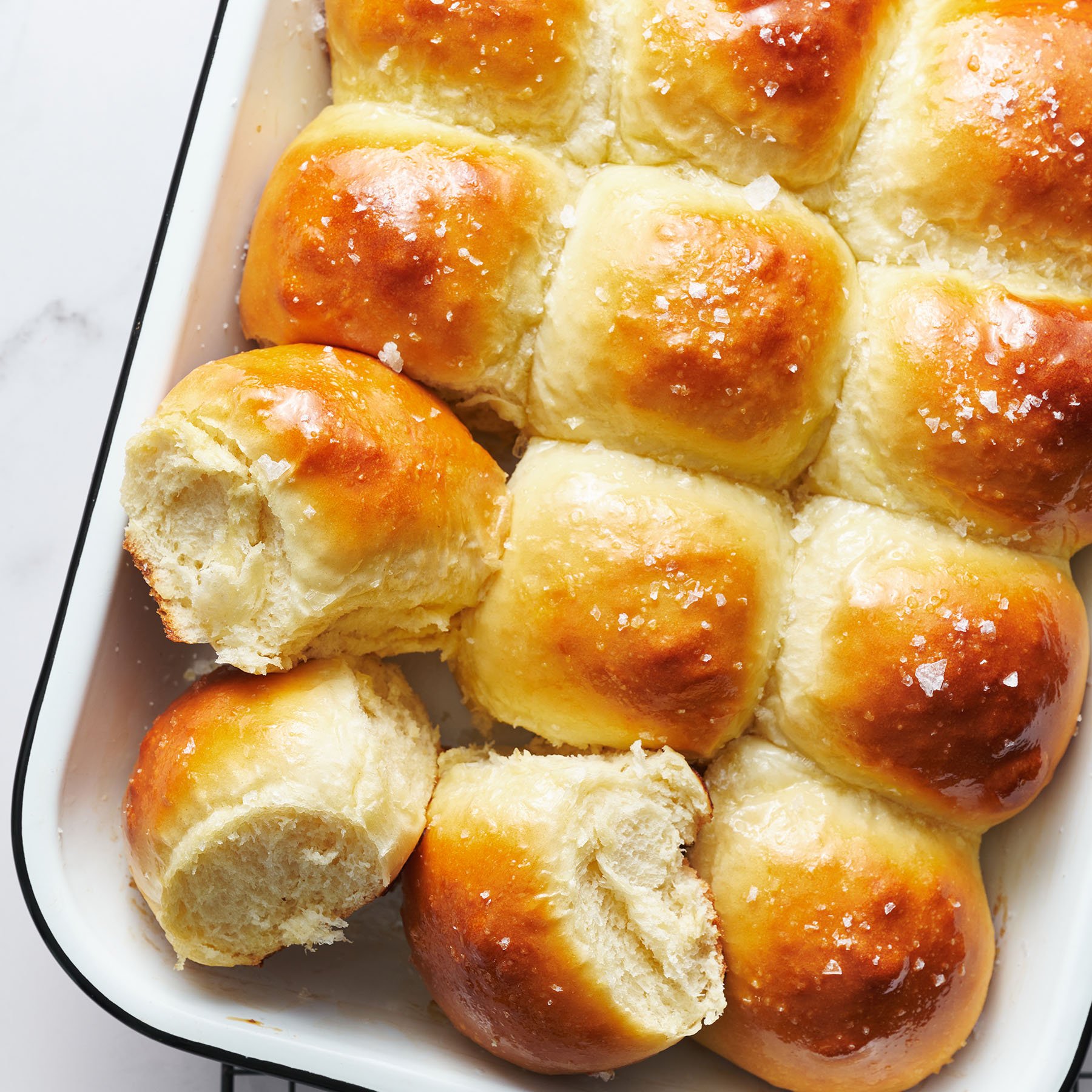
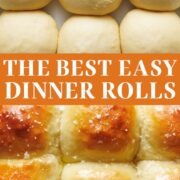


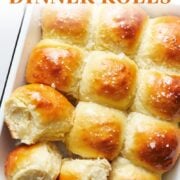
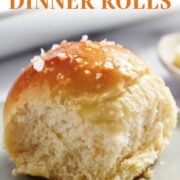
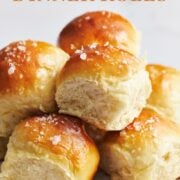
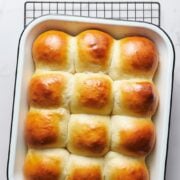
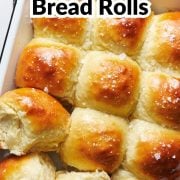
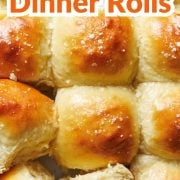
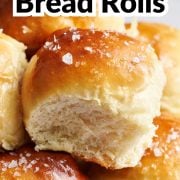
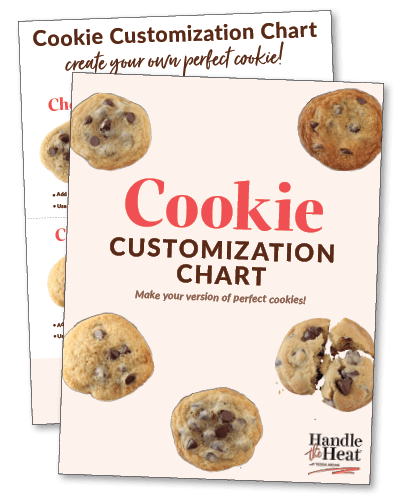
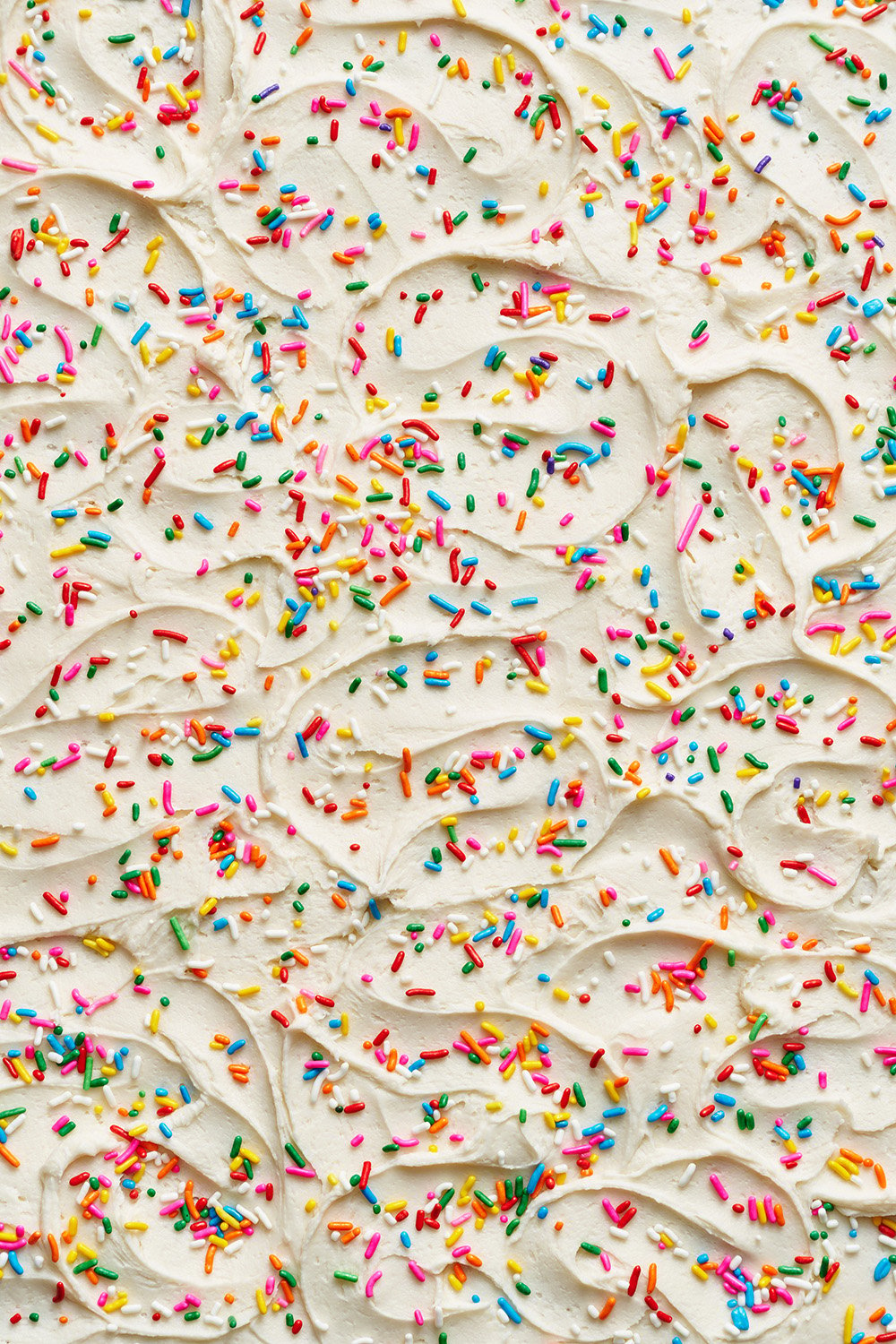
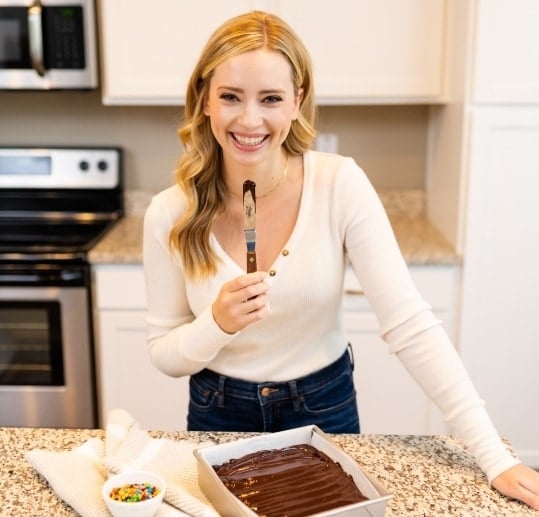

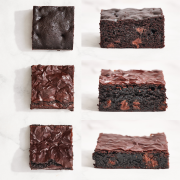
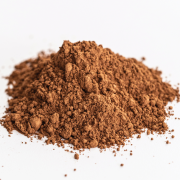
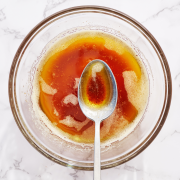
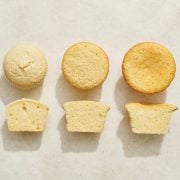

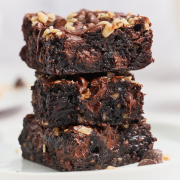
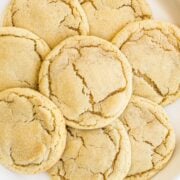









Hi! I have active yeast, is there a difference in the recipe if using active instead of instant?
I found the answer 🙂 thanks!
I make this recipe all the time. My family nd friends love them. I was wondering if this recipe could make a loaf of bread?
Wanted something between Hawaiian Sweet Rolls and normal dinner rolls. Baked according to recipe except I switched the water for pineapple juice and the white granulated sugar with brown sugar but otherwise followed the recipe as written. Turned out really well.
Have you made these the day before serving ever? I know you write they are best made day of!
Hi Anna! Yes, as noted, these are definitely best the day they’re made – but they’ll still be tasty the next day, if needed. Check out Tessa’s make-ahead instructions in the Tip Box, just above the recipe, under the heading ‘How to Make Dinner Rolls Ahead of Time’ for more tips on preparing these rolls ahead of time 🙂 I hope that helps! Happy baking 🙂
I was just sent this recipe with a very high recommendation. Will try it but wondered if anyone has tried the recipe in a bread machine for the mixing.
Hi Cherie! So glad to hear that this recipe came highly recommended! We haven’t tried using a bread machine for the kneading portion. It’s super easy to knead on a stand mixer, but if you don’t have one, check out Tessa’s tips for this in the Tip Box (above the recipe) under the heading, “Can I Knead the Dough By Hand?” – and be sure to check out all the other tips there, too! I hope that helps! Let us know how it goes if you give these rolls a try 🙂
These were delicious! I tested these side-by-side with two other highly rated dinner roll recipes. In my opinions, these had the best, buttery, yeasty flavor. Although they rose very tall and were very flaky and fluffy, they are chewy and satisfying. Even more, they look beautiful and shiny.
I’m known for not being able to bake with yeast. This recipe changed that. I cant wait to try more of your recipes! Thank you!!
Yayy! That makes us SO happy to hear, Jen! Well done 🙂
This simple dinner roll recipe will assure you never buy rolls from the store again. They’re foolproof and turn out pillowy soft every time. The options are endless when it comes to flavors and toppings, but they’re a perfect side with just butter. Flakey salt also goes so well on these!
Your rolls look perfect, Kate! So glad these were a hit for you 🙂
I’ve made these several times. Big hit!